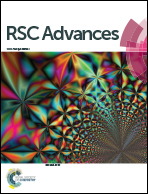A highly zinc-selective ratiometric fluorescent probe based on AIE luminogen functionalized coordination polymer nanoparticles†
Abstract
Coordination polymer nanoparticles (CPNs) formed by self-assembly of metal ions (or clusters) and organic bridging ligands through coordination bonds provide a unique platform for designing multifunctional nanoparticles. In this work, we report a ratiometric fluorescent probe for Zn2+ based on CPNs, which were prepared from AIE fluorophore HDBB molecules with metal ions. The CPNs are composed of HDBB molecules with Tb3+ (named Tb-HDBB-CPNs) which displayed a matrix coordination-induced emission peak at a wavelength of 590 nm, while CPNs formed by HDBB molecules and Zn2+ (named Zn-HDBB-CPNs) showed a distinctive fluorescent property with a blue emission peak wavelength of 470 nm. Based on the cation exchange process of Tb-HDBB-CPNs with Zn2+, a highly selective ratiometric fluorescent probe for the determination of Zn2+ in aqueous solution was developed with a linear range from 0.1 to 60 μM and a detection limit of 50 nM. Our approach using AIE molecules as organic ligands for the construction of CPNs paves a way toward AIE functionalized materials with ratiometric fluorescence response and will find wide applications in chemical sensing.



 Please wait while we load your content...
Please wait while we load your content...